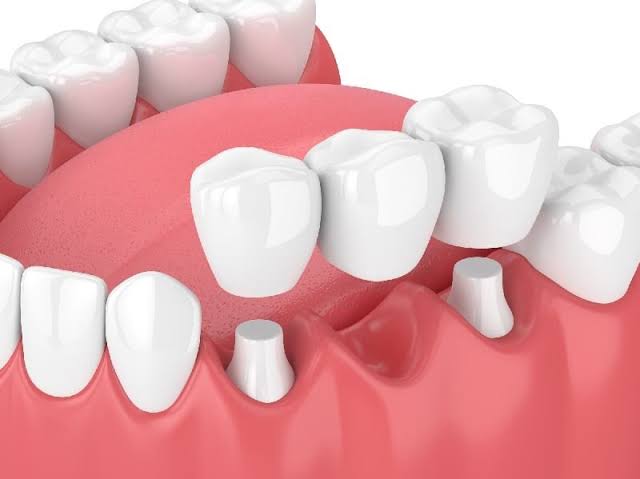Dental Bridge

Dental Bridge
A bridge may be recommended if tooth loss occurs. A bridge consists of a replacement tooth/teeth attached to crowns on each side.The bridge is cemented to the teeth adjacent to the space, effectively replacing the missing tooth and preventing any shifting.
Dental crowns are made of all porcelain, metal, zirconia, porcelain fused to metal. The type of crown utilized during your dental crown procedure will depend on your unique needs and goals, as well as the recommendation of your dentist.
The loss of a single tooth can have a major impact on our dental health and personal appearance. Our teeth support and rely on each other. When one or more teeth are missing, the remaining teeth can shift out of their normal position. Teeth adjacent to the space or from the opposite jaw will often drift or tilt. These teeth are often more susceptible to decay and gum disease because they are more difficult to clean around. All of this shifting and drifting will lead to changes in the bite, which may put stress on the jaws, muscles and teeth. Ultimately, our ability to chew comfortably and our appearance may be affected.
Benefits of Dental Bridges
Prevents remaining teeth from drifting out of position
Restores your ability to properly chew and speak
Helps preserve the natural function and position of the teeth
Maintains the shape of your face
Procedure for
Dental Bridges
Teeth Examination
The procedure for installing a dental bridge normally takes two – three separate visits, usually it total of 10 days. At your first appointment, your dentist will examine the adjacent teeth to make sure that it can support a bridge. X-rays are taken of the tooth and bone around it. If decay is found or there is an infection to the tooth’s pulp, a root canal treatment may need to be done first.
Teeth Preparation
A local anesthetic is used to numb the teeth while the Dentist will file it down to prepare for the crown. Alternatively, if the tooth is severely damaged or broken, the dentist may need to fill it in to make it large enough to properly receive the crown
Temporary Bridge Placement
After the teeth are filed or filled to the proper shape, the Dentist will take an impression of the teeth and the surrounding, then send it to the dental laboratory, so the permanent bridge can be made accordingly. By the end of this first visit, your teeth will have a new temporary bridge that protects it until the final bridge is ready to be permanently placed.
Bridge Trial and Installation
When the permanent bridge is ready, you will have your second visit. At this appointment, the dentist will try-in the bridge on the prepared teeth. Once the fit, shade and position is perfect the dentist will cement the new bridge on the teeth using a permanent resin cement.
Once your dental bridge procedure is complete, it may take some getting used to before it feels normal in your mouth; however, after a little time has passed, the bridge should look, function, and feel like a regular tooth.
- GENERAL DENTISTRY
- COSMETIC DENTISTRY
- ORTHODONTICS
- ORAL SURGERY
- PEDIATRIC DENTISTRY
- PROSTHODONTICS
- ENDODONTICS
- PERIODONTICS
- DIGITAL X-RAYS



